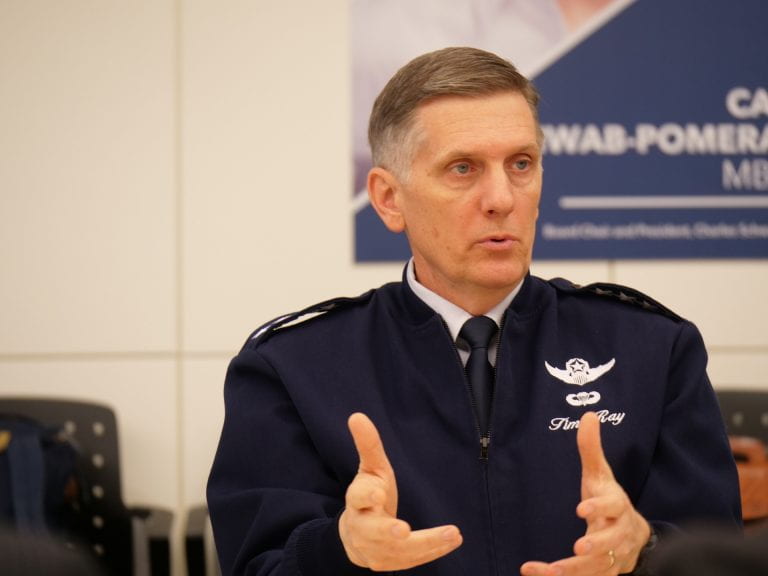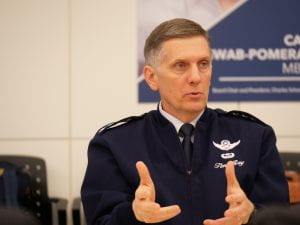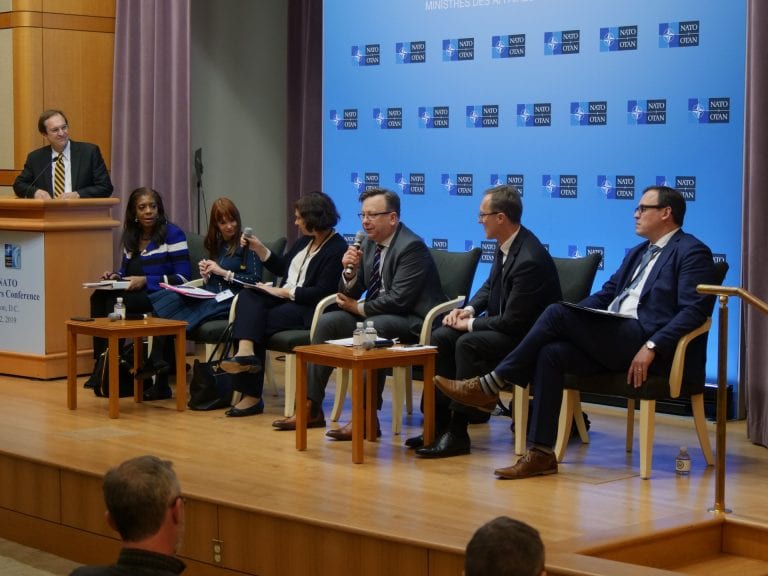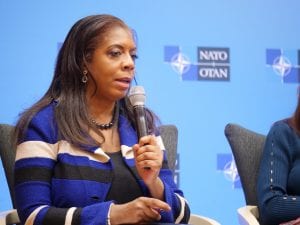AFGSC Chief Says It’s Too Early to Decide Bomber Force Size, by John Tirpak of Air Force Magazine
The head of Air Force Global Strike Command believes the bomber force needs to grow, but he thinks it’s too early in the development cycle of the B-21 Raider to decide by how much because the jet’s final cost is not yet known.
Gen. Timothy Ray, speaking with reporters in Washington, D.C., on Wednesday, said AFGSC’s “Bomber Vector” was developed before the new National Defense Strategy was written, and he’s not ready yet to say the roadmap should be implemented.
“My job … is to keep as many options on the table as long as I possibly can,” Ray said. It won’t be known until about 2024 what the production cost of the new B-21 bomber will be, he said, because that’s the transition point between development, construction of the initial test aircraft, and the production version. Deciding on a final production number before that point would be “gambling,” Ray said, because it’s impossible to know what the world situation or the “fiscal realities will look like” before then.
Ray acknowledged that facilitizing for a rapid production of the new bomber would probably cost less than buying more slowly.
“[If] you think … about rate per year to get to your fleet size earlier and the savings that gives you, to build out the fleet faster is cheaper,” he admitted. “But like anything, you pay more up-front” to get high-capacity production. Though the Air Force has never said how quickly it plans to build B-21s, a number of officials have suggested it will be slow. The Bomber Vector said the B-2 and B-1 would start phasing out circa 2031, because the bulk of the B-21 fleet would be delivered by then. A fleet of 100 bombers delivered over seven years translates to production of fewer than 14 per year, since at least some early test versions are expected to be converted for operational use.
He also suggested the Air Force has “learned from” the B-2 and F-22 programs, where it paid industry to gear up for mass production and ended up buying far fewer than expected, raising unit costs.
The bomber roadmap was “the product of an evolutionary process,” and the shifting of “two commands with two bombers” to “one command with four bombers, and the NDS,” Ray noted. Still to be mixed into the bomber equation is the service’s “The Air Force We Need” analysis released last fall; a study by the Center for Strategic and Budgetary Assessments, and “certainly Mitre (Corp.) was asked to give an input,” Ray said, adding that he’d seen bomber fleet analysis from AFA’s Mitchell Institute as well. “When I look at those particular dimensions, every indication is that the bomber force needs to grow,” he asserted.
The US no longer enjoys the “sanctuary” of being behind two oceans, “so our ability to project power, I think, grows more important,” Ray said. “Every indication is that the Air Force will be at the forefront of any conflict of any dimension.” He also said he feels the bomber force specifically is “under-invested” in hypersonics, counterspace, and counter-maritime capabilities. He needs to “close some of these gaps that I see that are growing” and do so “smarter, better, faster, cheaper.”
The Air Force has only said it needs “at least” 100 B-21s, Ray said, but “I shouldn’t come to Congress or the Secretary or the American people and say the answer to this is to simply print me 250 B-21s,” Ray asserted. “We need a minimum of 100, but the decision to make that move is in the outyears.”
“We can’t spend our way out of this,” Ray said broadly of all the strategic modernization programs, including bombers, that are underway. “We’re going to have to be really smart about how we do business.”
The B-21 is “a very strong acquisition program,” he emphasized, reporting that flight testing will get underway in 2021 and USAF also will have a certain number of jets as a test fleet in that same time period.
Although, “We’re not going to know the real price tag until the [20]24-25 timeframe, I’m confident those numbers are going to be very favorable, because cost is a KPP [key performance parameter], and I think the CDR [Critical Design Review] was very favorable for the B-21,” Ray said.
Technology lessons have also been learned from the B-2 and F-35, Ray said. “Now we’re talking about managing the algorithms for conditions-based maintenance in the B-21 before we even build it,” he noted. “We’re talking about digital modeling and 3-D printing to validate maintenance practices.” Doing that “in 2019 for an airplane that’s six or seven years away, I think that’s indicative of the thinking that’s going on.”
In the meantime, the service also is working to upgrade its existing bombers, having awarded Boeing a contract last week for up to $14 billion to keep the legacy bombers viable and relevant.
There’s “a lot going on” with adding targeting pods, the integrated battle station on the B-1, the CONECT digital backbone for the B-1 and B-52; radar modernization, re-engining the B-52, and generally “what it’s going to take to keep those old airplanes going,” he asserted. The fleet modernization is a sprawling effort, but Ray reported “a great relationship at the general officer level” between the acquisition directorate, Air Combat Command, AFGSC, and “the sustainment community about how you shift from where you are to the future.” He added there are “probably smarter behaviors when you talk about flying a 1960s airplane to the 2050s.”
The work will also cover digitizing parts so that replacements can be printed. Air Force acquisition chief Will Roper said last week that printing parts is a huge cost-saver because it eliminates the need to “essentially … do the development” of a component all over again, when the service is only looking to produce a small handful of items, for which industry must present a big bill.
Original article can be found here.
Other articles:
Military.com: Overtasking of B-1 Lancer Fleet Led to Faster Deterioration, General Says
Defense One: New Nuclear Missiles’ Cost Estimate Changes Again
National Defense Magazine: JUST IN: Air Force Still Inspecting B-1 Bombers Amid Safety Concerns
SIGNAL Magazine: Smart Strategic Deterrence Leverages Digital Engineering
Jane’s Defense: US Air Force finding minor issues following B-1B grounding
Defense Daily: AF Global Strike Command Leader Expects Cost of New ICBM to Increase in Short Term
Task & Purpose: The Air Force's B-1B Lancer fleet is stretched thin and falling apart, general says







